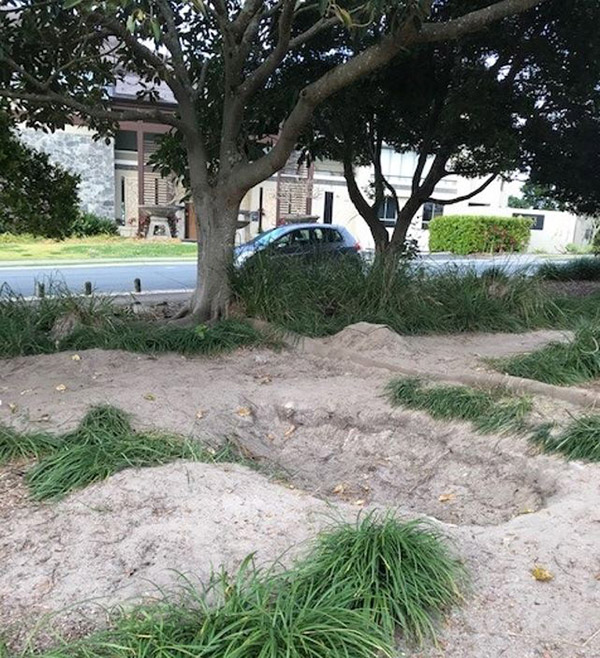Unauthorised bike tracks and jumps
 Some bike tracks and jumps in our local open spaces are small in scale. These pose little risk to public safety and create minimal environmental impact.
Some bike tracks and jumps in our local open spaces are small in scale. These pose little risk to public safety and create minimal environmental impact.
Others are extensive and can be dangerous and cause significant damage to the environment. There's also the potential risk to public safety.
We have adopted a balanced approach to address unauthorised bike tracks and jumps. We check them to determine what to do to prevent any risk.
We'll remove them if their construction and use:
- become excessive
- impacts our environment
- becomes a risk to public safety.
Read the FAQs below to find out more, including our long term plan that includes new bike facilities in the Tweed.
If you see a problem with a bike track or jump, report it online. For emergencies call 000 (triple zero).
Bike tracks and jumps FAQs
What’s the issue with bike tracks and jumps?
Unauthorised bike tracks and jumps are not built to any standard. They're also not inspected for safety. Obstacles, holes and jumps can create a safety hazard to other people and is often a source of complaints.
Construction of tracks and jumps can result in damage to the surrounding environments. This include areas with endangered ecological communities, threatened species or Aboriginal heritage value.
Just because ‘no one is using the bush’ doesn't mean it's not important to others. Its biodiversity and intrinsic environmental value are important to the community.
In some locations, trees have been cut down and branches snapped off. Erosion is also evident in some previously turfed areas.
What’s the risk to public safety?
Obstacles, holes and bike jumps pose a safety risk to other users of our parks and open spaces.
These are places set aside by Council to meet community needs for passive recreation or outdoor exercise opportunities.
Unfortunately, some bike jump holes are so deep that they pose a serious trip hazard, as are the rocks that have been dug up and left lying around.
What environmental impacts do bike tracks and jumps have?
The Tweed has significant areas of bushland. Our bushland is a valued environmental resource. It's an important part of our natural and cultural heritage and creates a unique sense of place and identity.
Community surveys show that residents have a strong connection with the natural environment and place high importance on its protection. We have a responsibility to protect the environmental values and biodiversity of bushland.
Tree removal, clearing, creating an increasing number of tracks, excavating and mounding of soil for bike riding are unacceptable in bushland reserves.
When will bike tracks and jumps be removed?
Bike tracks and jumps will be removed when:
- jumps and holes are causing safety hazards
- jumps and holes are impacting the amenity in high-use parks
- jumps and holes are affecting the safety of playground users or other open space users
- plants and trees are being damaged or removed.
Where bike tracks and jumps are tolerated, any illegal activity, threats to the public or further impact on the environment will also result in their removal.
When will bike tracks and jumps be tolerated?
In some cases, bike tracks and jumps may be tolerated where they have low impact and offer a level of recreational value to the community. For example:
- jumps and holes pose minimal safety risk and do not impact on public amenity in high-use parks
- jumps and holes are not located near playgrounds and do not pose a safety risk to children and carers
- there is minimal impact to vegetation and plants and trees are not damaged or removed.
What is Council doing about risks to the public and to bike riders?
In all cases of unauthorised bike tracks and jumps in our parks and open spaces, Council advises that:
- pedestrians and park users should keep clear of riders, tracks and jumps
- bike riding is a dangerous recreational activity and riders use bike tracks and jumps at their own risk
- we are monitoring sites to determine if an unacceptable public safety risk or damage to the environment is occurring.
What will removal and rehabilitation works consist of?
Rehabilitation works may include:
- filling in holes to make the activity safe for riders and other members of the community
- installing signage to notify the community that creating bike tracks and jumps is unauthorised
- removing jumps, rocks, debris and rubbish
- installing temporary fencing to block future access
- using logs and branches to block tracks and cleared areas to allow the bush to regenerate
- planting and mulching to mitigate environmental impacts.
What bike facilities has Council opened in the Tweed?
Our Open Space Strategy 2019–2029(PDF, 3MB) guides the planning, development and management of public open spaces, sport and recreation facilities across the Tweed.
Key actions from the Open Space Strategy are underway to meet the increased demand for bike facilities in the Tweed: